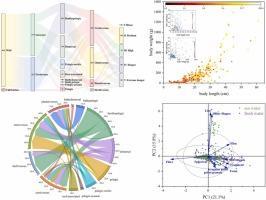基于meta分析的水生生物微塑料全球分布特征及生态风险评价
IF 11.3
1区 环境科学与生态学
Q1 ENGINEERING, ENVIRONMENTAL
引用次数: 0
摘要
随着自然环境中微塑料污染的加剧,水生生物面临的微塑料污染风险越来越受到广泛关注。大多数研究主要集中在微塑料对特定区域和特定物种的影响上。然而,随着微塑料的全球迁移,有必要对微塑料在各种水生生物中的分布特征、摄入机制和生态影响进行全面研究。为了弥补这一研究空白,本研究系统地评估了微塑料在全球水生生物中的分布状况,并评估了其潜在的生态风险。本文首先综述了微塑料的来源及其对水生生物的影响。其次,采用文献计量学分析来检查当前的研究现状和趋势,并定量分析水生生物的生物学特性如何影响微塑料的摄入以及微塑料在这些生物体内的分布模式。第三,本研究通过研究微塑料对不同营养水平生物的影响,探讨了微塑料影响水生食物链的机制。最后,提出了减少微塑料进入水体的策略和未来的研究方向。研究结果为全球微塑料污染控制提供了科学依据和决策支持,旨在保护水生生态系统的健康和可持续发展。本文章由计算机程序翻译,如有差异,请以英文原文为准。

Global Distribution Characteristics and Ecological Risk Assessment of Microplastics in Aquatic Organisms Based on Meta-Analysis
As microplastic pollution in the natural environment intensifies, the risk of microplastic contamination faced by aquatic organisms has garnered increasing widespread attention. Most studies have primarily focused on the impacts of microplastics within specific regions and on particular species. However, with the global migration of microplastics, it is necessary to conduct comprehensive research on the distribution characteristics, ingestion mechanisms, and ecological impacts of microplastics across various aquatic organisms. To address this research gap, the present study systematically evaluates the distribution status of microplastics in global aquatic organisms and assesses their potential ecological risks. Firstly, a review of the sources and impacts of microplastics within aquatic organisms is provided. Secondly, a bibliometric analysis is employed to examine the current research landscape and trends, coupled with a quantitative analysis of how the biological characteristics of aquatic organisms influence microplastic ingestion and the distribution patterns of microplastics within these organisms. Thirdly, the study investigates the mechanisms by which microplastics affect aquatic food chains by examining their impact on organisms at different trophic levels. Finally, strategies to reduce microplastic input into water bodies and future research directions are proposed. The findings offer scientific foundations and decision-making support for global microplastic pollution control, aiming to protect the health and sustainable development of aquatic ecosystems.
求助全文
通过发布文献求助,成功后即可免费获取论文全文。
去求助
来源期刊

Journal of Hazardous Materials
工程技术-工程:环境
CiteScore
25.40
自引率
5.90%
发文量
3059
审稿时长
58 days
期刊介绍:
The Journal of Hazardous Materials serves as a global platform for promoting cutting-edge research in the field of Environmental Science and Engineering. Our publication features a wide range of articles, including full-length research papers, review articles, and perspectives, with the aim of enhancing our understanding of the dangers and risks associated with various materials concerning public health and the environment. It is important to note that the term "environmental contaminants" refers specifically to substances that pose hazardous effects through contamination, while excluding those that do not have such impacts on the environment or human health. Moreover, we emphasize the distinction between wastes and hazardous materials in order to provide further clarity on the scope of the journal. We have a keen interest in exploring specific compounds and microbial agents that have adverse effects on the environment.
 求助内容:
求助内容: 应助结果提醒方式:
应助结果提醒方式:


